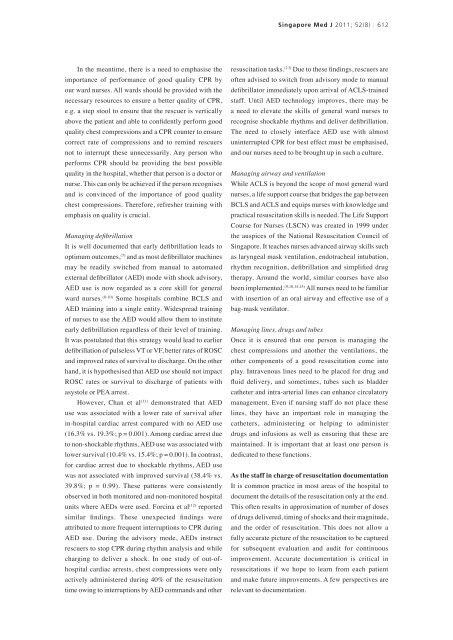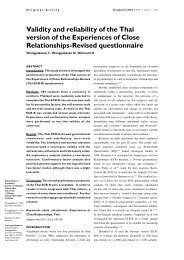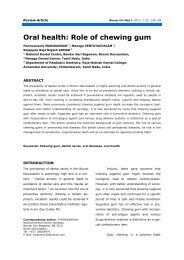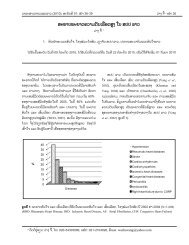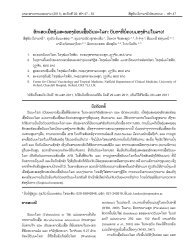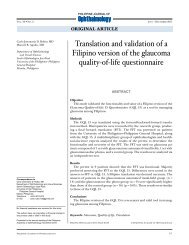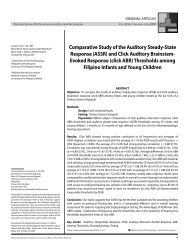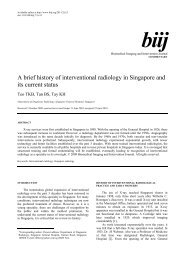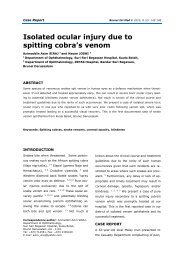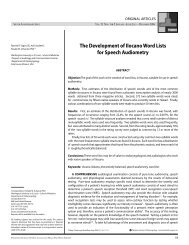PDF ( B) - APAMED Central
PDF ( B) - APAMED Central
PDF ( B) - APAMED Central
You also want an ePaper? Increase the reach of your titles
YUMPU automatically turns print PDFs into web optimized ePapers that Google loves.
Singapore Med J 2011; 52(8) : 612<br />
In the meantime, there is a need to emphasise the<br />
importance of performance of good quality CPR by<br />
our ward nurses. All wards should be provided with the<br />
necessary resources to ensure a better quality of CPR,<br />
e.g. a step stool to ensure that the rescuer is vertically<br />
above the patient and able to confidently perform good<br />
quality chest compressions and a CPR counter to ensure<br />
correct rate of compressions and to remind rescuers<br />
not to interrupt these unnecessarily. Any person who<br />
performs CPR should be providing the best possible<br />
quality in the hospital, whether that person is a doctor or<br />
nurse. This can only be achieved if the person recognises<br />
and is convinced of the importance of good quality<br />
chest compressions. Therefore, refresher training with<br />
emphasis on quality is crucial.<br />
Managing defibrillation<br />
It is well documented that early defibrillation leads to<br />
optimum outcomes, (7) and as most defibrillator machines<br />
may be readily switched from manual to automated<br />
external defibrillator (AED) mode with shock advisory,<br />
AED use is now regarded as a core skill for general<br />
ward nurses. (8-10) Some hospitals combine BCLS and<br />
AED training into a single entity. Widespread training<br />
of nurses to use the AED would allow them to institute<br />
early defibrillation regardless of their level of training.<br />
It was postulated that this strategy would lead to earlier<br />
defibrillation of pulseless VT or VF, better rates of ROSC<br />
and improved rates of survival to discharge. On the other<br />
hand, it is hypothesised that AED use should not impact<br />
ROSC rates or survival to discharge of patients with<br />
asystole or PEA arrest.<br />
However, Chan et al (11) demonstrated that AED<br />
use was associated with a lower rate of survival after<br />
in-hospital cardiac arrest compared with no AED use<br />
(16.3% vs. 19.3%; p = 0.001). Among cardiac arrest due<br />
to non-shockable rhythms, AED use was associated with<br />
lower survival (10.4% vs. 15.4%; p = 0.001). In contrast,<br />
for cardiac arrest due to shockable rhythms, AED use<br />
was not associated with improved survival (38.4% vs.<br />
39.8%; p = 0.99). These patterns were consistently<br />
observed in both monitored and non-monitored hospital<br />
units where AEDs were used. Forcina et al (12) reported<br />
similar findings. These unexpected findings were<br />
attributed to more frequent interruptions to CPR during<br />
AED use. During the advisory mode, AEDs instruct<br />
rescuers to stop CPR during rhythm analysis and while<br />
charging to deliver a shock. In one study of out-ofhospital<br />
cardiac arrests, chest compressions were only<br />
actively administered during 40% of the resuscitation<br />
time owing to interruptions by AED commands and other<br />
resuscitation tasks. (13) Due to these findings, rescuers are<br />
often advised to switch from advisory mode to manual<br />
defibrillator immediately upon arrival of ACLS-trained<br />
staff. Until AED technology improves, there may be<br />
a need to elevate the skills of general ward nurses to<br />
recognise shockable rhythms and deliver defibrillation.<br />
The need to closely interface AED use with almost<br />
uninterrupted CPR for best effect must be emphasised,<br />
and our nurses need to be brought up in such a culture.<br />
Managing airway and ventilation<br />
While ACLS is beyond the scope of most general ward<br />
nurses, a life support course that bridges the gap between<br />
BCLS and ACLS and equips nurses with knowledge and<br />
practical resuscitation skills is needed. The Life Support<br />
Course for Nurses (LSCN) was created in 1999 under<br />
the auspices of the National Resuscitation Council of<br />
Singapore. It teaches nurses advanced airway skills such<br />
as laryngeal mask ventilation, endotracheal intubation,<br />
rhythm recognition, defibrillation and simplified drug<br />
therapy. Around the world, similar courses have also<br />
been implemented. (9,10,14,15) All nurses need to be familiar<br />
with insertion of an oral airway and effective use of a<br />
bag-mask ventilator.<br />
Managing lines, drugs and tubes<br />
Once it is ensured that one person is managing the<br />
chest compressions and another the ventilations, the<br />
other components of a good resuscitation come into<br />
play. Intravenous lines need to be placed for drug and<br />
fluid delivery, and sometimes, tubes such as bladder<br />
catheter and intra-arterial lines can enhance circulatory<br />
management. Even if nursing staff do not place these<br />
lines, they have an important role in managing the<br />
catheters, administering or helping to administer<br />
drugs and infusions as well as ensuring that these are<br />
maintained. It is important that at least one person is<br />
dedicated to these functions.<br />
As the staff in charge of resuscitation documentation<br />
It is common practice in most areas of the hospital to<br />
document the details of the resuscitation only at the end.<br />
This often results in approximation of number of doses<br />
of drugs delivered, timing of shocks and their magnitude,<br />
and the order of resuscitation. This does not allow a<br />
fully accurate picture of the resuscitation to be captured<br />
for subsequent evaluation and audit for continuous<br />
improvement. Accurate documentation is critical in<br />
resuscitations if we hope to learn from each patient<br />
and make future improvements. A few perspectives are<br />
relevant to documentation.


